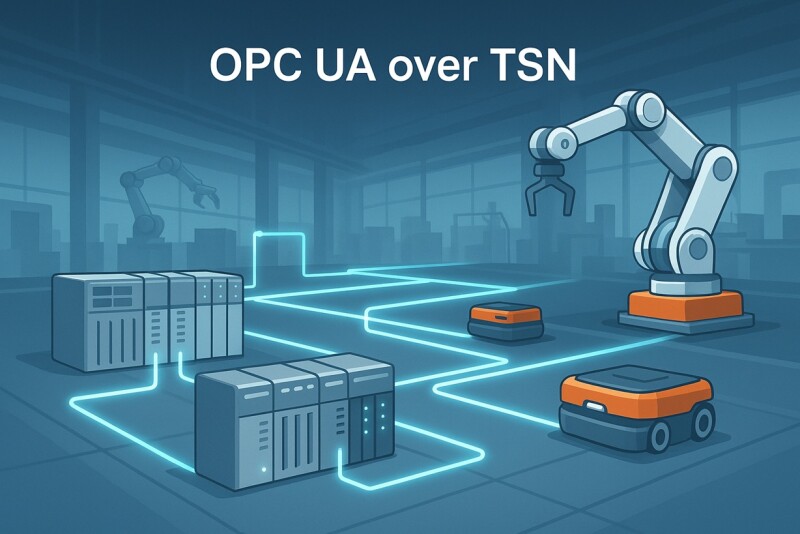OPC UA over TSN Explained: Determinism Without Vendor Lock-In
For decades, industrial networks were divided by proprietary protocols — PROFINET, EtherCAT, Ethernet/IP, and others. Each offered fast, deterministic communication but locked users into a single vendor ecosystem. The combination of OPC UA (Open Platform Communications Unified Architecture) and TSN (Time-Sensitive Networking) finally breaks that wall, offering deterministic performance and full interoperability across vendors.
What Is OPC UA?
OPC UA is a vendor-neutral communication standard managed by the OPC Foundation. It enables secure, structured, and platform-independent data exchange across industrial devices, PLCs, sensors, and IT systems. Unlike legacy fieldbuses, OPC UA operates over standard Ethernet and supports hierarchical information models — perfect for Industry 4.0 architectures.
What Is TSN?
Time-Sensitive Networking (TSN) is a set of IEEE Ethernet standards (IEEE 802.1) that bring determinism and guaranteed latency to standard Ethernet networks. It synchronizes clocks across devices, schedules traffic, and ensures time-critical data always arrives on time — even in mixed IT/OT networks.
Why Combine Them?
OPC UA provides structured, secure communication. TSN adds deterministic transport. Together, they enable real-time, vendor-independent communication — allowing motion controllers, PLCs, and robots to exchange synchronized data over standard Ethernet.
This makes it ideal for hybrid environments such as modular cobot cells and AMR fleets that must communicate reliably with SCADA and cloud systems.
Key Technical Features
- Time Synchronization: via IEEE 802.1AS, aligning clocks across all nodes.
- Traffic Scheduling: guarantees bandwidth for high-priority control traffic.
- Seamless Integration: coexists with non-deterministic Ethernet traffic (IT + OT convergence).
- Security: inherits OPC UA’s encryption and authentication mechanisms.
How It Enables Vendor Independence
With OPC UA over TSN, manufacturers can mix and match devices from different suppliers without worrying about compatibility. It eliminates proprietary gateways and reduces integration cost. This aligns with the open interoperability goals defined in Edge AI in the Factory — enabling smart devices to connect directly at the data layer.
Performance in Practice
OPC UA over TSN can achieve latencies below 1 ms with microsecond-level jitter — comparable to or better than traditional real-time fieldbuses. When combined with TSN configuration tools and next-generation Industrial Ethernet standards, it forms the backbone of truly deterministic, scalable communication networks.
Use Cases
- Multi-vendor robot cells: real-time control without proprietary drivers.
- Smart factories: integration of IT analytics with real-time production data.
- AMR coordination: low-latency communication between mobile fleets and central AI.
- Predictive maintenance: synchronized sensor data for Predictive Maintenance 2025 analytics.
Challenges and Outlook
The biggest challenge remains widespread implementation. While major automation vendors (Siemens, Rockwell, Beckhoff) support OPC UA, full TSN integration is still maturing. Expect rapid adoption as industrial switches and controllers become TSN-ready by 2026.
Related Articles
- Edge AI in the Factory: How Smart Devices Bring AI Closer to Production
- Time-Sensitive Networking (TSN) in Practice
- Industrial Ethernet vs Fieldbus 2025: A Complete Comparison
- How AI Optimizes AMR Fleet Management
- Predictive Maintenance 2025: Sensors, Signals, and Real ROI
Quick Q&A
Q: Is OPC UA over TSN a replacement for fieldbuses?
A: Yes, gradually. It offers the same determinism and more flexibility — all over standard Ethernet.
Q: Can OPC UA over TSN work with legacy networks?
A: Yes. Gateways allow hybrid operation while upgrading gradually to TSN-capable hardware.
Q: What’s the main business benefit?
A: Vendor independence — reducing long-term costs and avoiding proprietary protocol lock-in.
Conclusion
OPC UA over TSN is the missing link between openness and real-time performance. By merging interoperable communication with deterministic networking, it enables truly connected, future-ready factories — where data flows freely and reliably across every device, regardless of brand or protocol.









































Interested? Submit your enquiry using the form below:
Only available for registered users. Sign In to your account or register here.